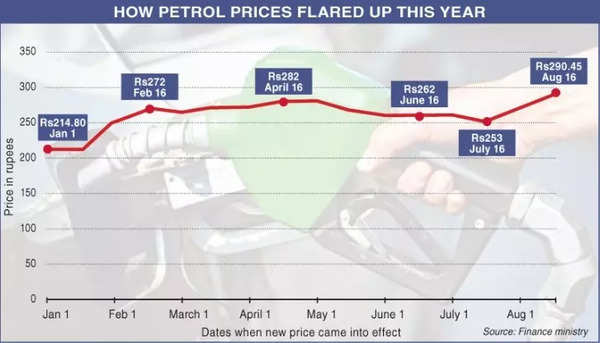Effective from Wednesday, the new petrol pricewill be PKR 290.45 per litre after a substantial rise of PKR 17.50 per litre, according to a notification from the finance division.High-speed diesel will witness an even steeper increase, with its price climbing by PKR 20 to reach PKR 293.40 per litre.
The ministry of finance released the revised prices late at night, following approval from caretaker Prime Minister Anwaarul Haq Kakar, who was sworn in on Monday.
Attributing the price hikes to the surge in international petroleum prices over the past two weeks, the finance division justified the increases in the prices of these key fuels.
However, the government’s notification did not mention any modifications to the prices of kerosene and light diesel oil.
This recent surge in petroleum prices closely follows a similar escalation imposed by the previous government on August 1. Consequently, fuel prices have surged by nearly PKR 40 per litre within a span of just 15 days.
Despite the deal with the International Monetary Fund(IMF), the economic slide of Pakistan is still continuing due to rising political uncertainties. Though, the Shehbaz Sharif has handed over power to a caretaker government, there is no clarity on election schedule yet. Questions are also being raised over the future of ex-PM Imran Khan, who is languishing in jail and has been barred from contesting elections.
Many companies are either shut or finding it difficult to operate on a daily basis due to difficulties in accessing the US dollar.
According to a Bloomberg report, the company responsible for assembling Suzuki vehicles in Pakistan is currently suspending its motorcycle plant for a period of 16 days until mid-August due to inventory shortages. Another example is Sitara Peroxide Ltd, a chemical manufacturer, which halted its factory operations for four weeks last month. Similarly, the producer of Toyota cars also faced a two-week shutdown of its plant.
The prevailing scarcity of dollars has compelled factories to remain closed for extended periods since Pakistan entered a crisis last year. This shortage of dollars has impeded the import of crucial raw materials, leading to a complete halt in production across various sectors, including steel and automobiles.
Following a receipt of substantial funds from the International Monetary Fund and other creditors in July, Pakistan is currently focused on maintaining currency stability as it endeavors to recover from its debt crisis. However, thousands of businesses are encountering significant hurdles in obtaining import permits necessary for their manufacturing requirements. This situation has led to cargo backlogs at ports, with the government imposing restrictions on dollar demand to safeguard the nation’s foreign exchange reserves.
(With inputs from agencies)
